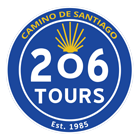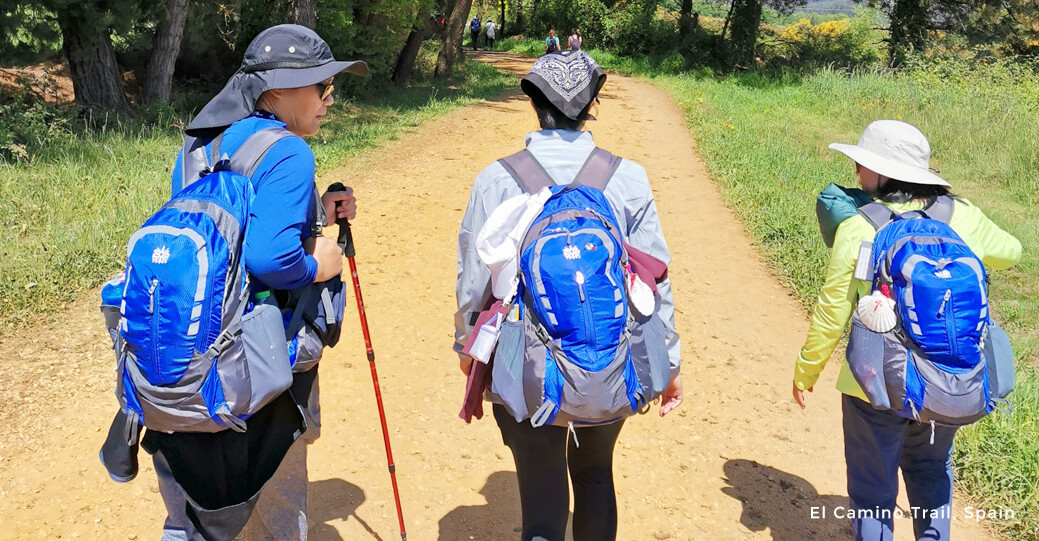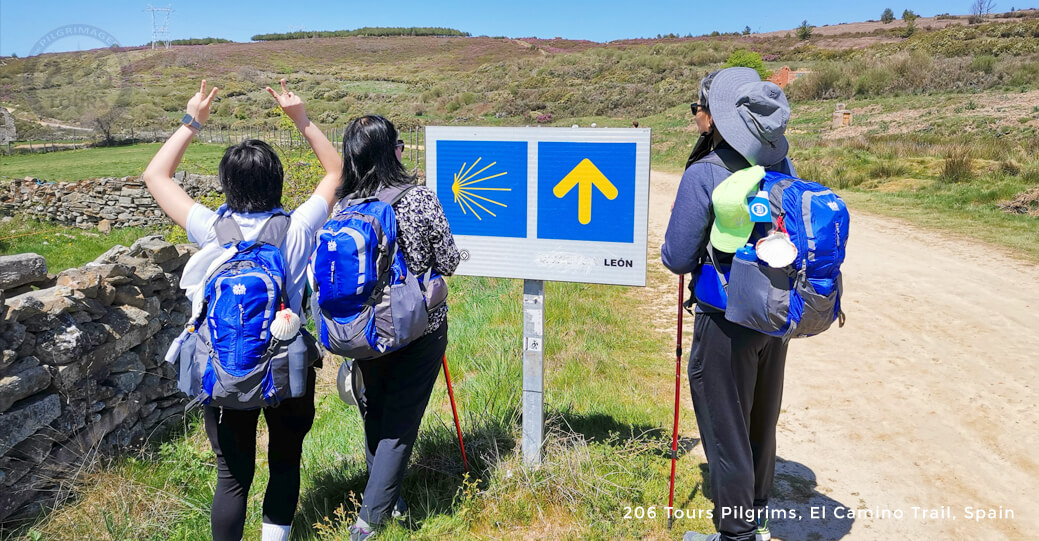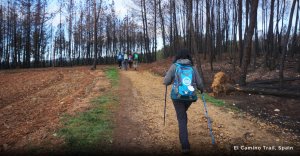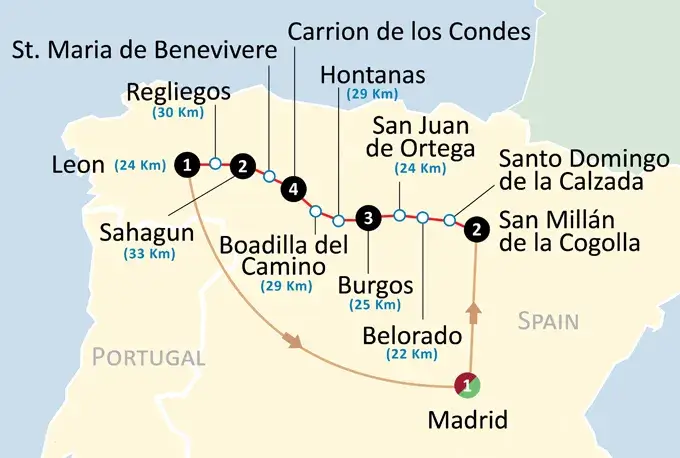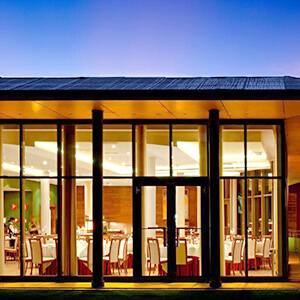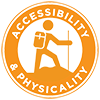Your trip includes
- Round-trip airfare from your desired Airport
- All airport taxes & fuel surcharges
- Hotel accommodations: (or similar) in double occupancy
- ~ 1 night: Preciados, Madrid, Spain
- ~ 2 nights: Parador de Santo Domingo de la Calzada, Santo Domingo de la Calzada, Spain
- ~ 3 nights: Abba Burgos, Burgos, Spain
- ~ 2 nights: Hotel Real Monasterio de San Zoilo, Salzburg, Austria
- ~ 2 nights: Hotel Puerta de Sahagun, Sahagun
- ~ 1 night: Hotel Real Monasterio de San Zoilo, Salzburg, Austria
- ~ 1 night: Preciados, Madrid, Spain
- Breakfast daily
- 10 Lunches
- Dinner Daily
- Wine and mineral water with dinners
- Transfers by air-conditioned coach or minibus
- Free WiFi & Water on bus
- Vehicle available to assist pilgrims who are unable to complete any leg of the tour
- Tour Escort throughout
- Local guide in San Millan de la Cogolla and Burgos
- Daily Maps
- Transfers as per itinerary
- Catholic Priest, Mass daily & Spiritual activities
- Hotel taxes and service charges
El Camino Accommodations:
Please be advised that we book you in the best available accommodations that are along the Camino trail. There are a limited number of places to stay along the Camino trail, without having to walk extra miles away from the Trail, and then back to the Trail to continue walking the route. These places range in Star Rating – simply because luxury hotels just do not exist.
While you will be removed from the routine of your everyday life, rest assured you will be taken care of with outstanding accommodations, meals and transportation with van / bus driving parallel to the path you walk each day. Should at any point you feel tired, need water, or any medical assistance, it will be readily available to you at check points that are set up along the way on your path. Tourists pass through places, places pass through Pilgrims.
Not Included
- Lunches and Beverages not mentioned, items of a personal nature, tips to guide and driver.
Itinerary
While you will be removed from the routine of your everyday life, rest assured you will be taken care of with outstanding accommodations, meals and transportation with van / bus driving parallel to the path you walk each day. Should at any point you feel tired, need water, or any medical assistance, it will be readily available to you at check points that are set up along the way on your path. Tourists pass through places, places pass through Pilgrims.
*Important Notice:
This itinerary involves an average of 13 – 20 miles daily of walking/hiking. It is essential that participants be in fit condition in order to complete the journey. We will have assistance vehicles (motor coach) available to assist pilgrims who are unable to complete a particular leg of the journey.
Day 1: Depart for Madrid
Make your way to your local airport where you will board your overnight flight(s). Your meals will be served on board.
Day 2: Madrid Airport – Madrid
Upon arrival in Madrid, you will collect your luggage in the baggage claim area, and continue to the Arrival’s Hall where you will be greeted by your driver/tour escort and transferred to your hotel. In the afternoon, walk to the Cathedral of Almudena and following Mass, you will visit the Cathedral. You will continue your walking tour of Madrid to include the exterior of the Royal Palace. Next, walk through the Plaza Mayor and Puerta del Sol and make a stop at the Church of Saint James. Lastly, return to your hotel, where you will enjoy a nice meal before having a restful overnight in Madrid before your walking tour begins!
Day 3: Madrid – San Millán de la Cogolla – Santo Domingo de la Calzada
Breakfast in the hotel. Departure towards Santo Domingo de la Calzada. The city was founded by a young shepherd called Domingo who had tried to join the monastery at San Millán de la Cogolla but was turned away because the young man was illiterate. After failing to enter the monastery he decided to become a hermit and set up his hermitage in some woods on a notorious part of the Camino and administered to the pilgrims who passed this way. A chance meeting with San Gregorio, who had helped rid Los Arcos of a plague of locusts, led Domingo to be ordained a priest. With the support of King Alfonso VI, who was keen to bring new settlers into the now mainly Muslim region, San Domingo began to build bridges and hostels and built a road between Nájera and Burgos. San Domingo died in 1109 at the age of 90 and became the patron saint of civil engineers. The saint was initially buried in a tomb at the side of the Camino, which he had built himself, but his admirers later buried him in the cathedral and named the city after him. The cathedral of San Salvador dates from the 12th century and is a mixture of Romanesque, Plateresque and Gothic. Inside we will find Santo Domingo’s mausoleum. At the rear of the cathedral there is an ornate chicken coup, the permanent home of a cockerel and a hen (which are replaced once a fortnight).The tradition behind the chickens came about through a story begun in the middle ages. In the afternoon we will visit the Monastery of Yuso, one of the two monasteries of San Millán de la Cogolla. The monasteries of Suso and Yuso were designated World Heritage on 4 December 1997 and as per the UNESCO evaluation noted, San Millán shows the transformation from an eremitic to a coenobitic community in material terms. The library of Yuso is one of the most important in Spain, not only on account of the number of documents it contains, but also for their age and value. The chronicles relate that when relics of San Millán were being moved to the Santa María la Real Monastery, the oxen that were pulling the cart stopped at a certain point and could not be made to continue. The king, García Sánchez, took this as a sign and ordered the monastery to be built on this spot. Dinner and overnight in the hotel.
Day 4: Santo Domingo de la Calzada – Belorado (22 km)
Leaving Santo Domingo de la Calzada over the Puente del Santo, Saint’s Bridge, El Camino will lead us to the town of Grañon. Dating back to the 9th century the town boasted a castle built by King Alfonso III to defend against Muslim invasion. The castle soon fell into ruins but the town prospered because of the Camino and at one time had two monasteries, a pilgrim hospice as well as fortifications. Unfortunately no traces of the walls remain and the only remaining building of note is the restored Church of Saint John the Baptist. After Grañon we will cross the border between La Rioja and Castilla y Leon autonomous communities, arriving to the first village of Castilla y Leon: Redecillo del Camino, a small, one street village that has owed its existence to the Camino since the 11th century. The village has a long history of caring for pilgrims and once had three pilgrim hospitals. Soon after we will arrive to Viloria de la Rioja, the birth place of Santo Domingo de la Calzada. Unfortunately, the house in which he was born has recently been demolished but the font in which he was baptized can be found in the parish church. The end of the stage will take us to Belorado. Lying in the valley of the Río Tirón in the shadow of the mountain, this town can trace its origins to Roman times. In Belorado you will be able to find the Churches of Saint Mary and Saint Peter and the Monasteries of Saint Mary of the Bretonera and Saint Clair. The Camino, once deviated from its original route, played a part in the town’s development. In medieval times the town had a thriving Jewish community, like so many other towns. The Jews were expelled by the Catholic Monarchs, Ferdinand and Isabella in the 15th century, which caused the ruin of the local economy. Unfortunately, the area hasn’t fared so well in modern times either with the gradual demise of the leather industry.
Day 5: Belorado – San Juan de Ortega (24 km)
After leaving Belorado we will find the hamlets of Tosantos and Villambistia. Villambistia is a small village with a great tradition surrounding its fountain. The story tells of a pilgrim, exhausted from his travels under the burning sun, being spotted by an elderly villager. The villager spoke to him about the Villambistia Tradition which consisted of completely immersing the head in the fountain of the village. This complete immersion would result in him being completely cured of all tiredness. The pilgrim did as the villager said and true to his word all semblance of exhaustion was wiped away. The pilgrim continued on his way to Santiago and regaled his fellow pilgrims with the story of the fountain. Over the centuries the story has been passed on by word of mouth and to this day pilgrims soak their head in the waters of the fountain. El Camino will lead us to the village of Villafranca de Montes de Oca, a beautiful village located in the valley at the foot of the Montes de Oca. The town’s name comes partly from that of the early Roman settlement of Auca, as well as from the Frankish (or French) settlers who came to the region in the middle ages when the Camino was at its most popular. Don’t miss the Church of the Apostle Saint James where you will find an impressive 143 pounds baptismal font in the shape of a giant scallop shell which is believed to have originated in the Philippines. The route from here towards Burgos takes us through the Montes de Oca, part of the Sistema Iberico mountain range which stretches from La Rioja down towards Valencia. On our journey you will pass the fountain dedicated to San Indalecio. According to the tradition the waters here began to flow on the site where San Indalecio, one of St James’ disciples, was believed to have been martyred. The mountain range between Villafranca and San Juan de Ortega is a nature reserve full of oak, juniper, ash and pine trees. On your journey we may be lucky enough to catch a glimpse some of the abundant wildlife such as foxes, otters and deer. At the end of the stage we will enter the small hamlet of San Juan de Ortega. San Juan de Ortega was, like his mentor San Domingo, an architect and prolific builder. He was involved in building a number of bridges, hospices and churches, all dedicated to helping the pilgrims on their journey through the region. San Juan has built a reputation of being the patron saint of fertility. The tradition refers to an incident when the tomb of the saint was opened and a swarm of white bees escaped from the tomb surrounded by a wonderful smell. The bees were believed to be the souls of unborn children being kept safe by San Juan until a suitable Christian woman could be found to bear that child. Queen Isabella the Catholic visited the church in 1477 after having being childless for a number of years. She went on to have three children, the first, a boy she named Juan and the second, a girl she named Juana. The Queen ordered the rebuilding of the chapel as it had fallen into disrepair and commissioned the canopy placed over the saint’s tomb.
Day 6: San Juan de Ortega – Burgos (25 km)
After leaving San Juan de Ortega we will cross the village of Ages before we arrive to Atapuerca. Atapuerca is not a large village but it has an impressive church, the Church of San Martin, which overlooks the village from a small hill. Atapuerca was once known as one of the first villages to have been wrested back from the Muslims during the Reconquista. However, in the 20th century Atapuerca became world famous for the discovery of the most important archaeological site ever to be found, situated in the Sierra de Atapuerca hills. The on-going archaeological dig was declared a world heritage site by UNESCO in 2000.The site was originally discovered in the 1960’s during the construction of a railway. However, since the 1980’s the remains of more than 32 individuals have been found in La Sima de los Huesos, or the pit of bones. Most of the bones found here are over 300,000 years but the remains of the Atapuerca Man, found in 1994, are over 800,000 years old, considered to be the oldest European man. Today we will end our stage in Burgos. Burgos has been on the pilgrim route from the very beginning and it is a place well worth spending a day, if not more in before we start on our next stretch of the journey through the flat plains of the Meseta. In the old part of the city we will find the remains of the old castle looking down onto the Gothic Cathedral of Saint Mary, declared a World Heritage Site in 1984. The building of the cathedral was commissioned in the 11th century by the King Fernando III and his German wife Beatrice of Swabia. The building of the cathedral was overseen by the English born Bishop Don Mauricio. The towers which dominate the skyline were designed and built by Hans of Cologne, bearing more than a passing resemblance to the great cathedral in Cologne. The cathedral is vast with a number of different chapels but perhaps one of the most interesting is the Chapel of the Christ of Burgos. Directly opposite this chapel above the Chapel of Santa Tecla you will find the Papamoscas. This is an automaton above a clock which opens and closes its mouth and strikes a bell on the hour. Also within the cathedral are buried the remains of Rodrigo Diaz de Vivar, better known worldwide as El Cid. Apart of the Cathedral we will find two very important monasteries in Burgos: The Monastery of Las Huelgas, a favorite place of retreat for the Castilian monarchs; and the Cartuja de Miraflores where nowadays a community of Carthusian monks lives in silence.
Day 7: Burgos - Hontanas (29 km)
From Burgos all the way to Leon we will be walking through the area known as the Meseta, a mostly flat uninspiring landscape. It is very hot in the summer and extremely cold in the winter. We will pass through the villages of Tardajo, where you will find the Church of Our Lady of the Assumption; and Rabe de las Calzadas and its Hermitage of Our Lady of the Monastery. Fom Rabe the path takes us through fields and pastures before we start climbing the Matamulos Hill. When we get to the top we will be faced with a wondrous sight, a landscape which for miles around is never endingly flat, devoid of trees but still in its own way, stunningly beautiful. Welcome to the Meseta. Later on we will arrive to Hornillos del Camino, where we will find the Church of San Roman and the Rooster Fountain. At the end of the stage we will arrive to the pilgrim village of Hontanas with its Immaculate Conception Church; and the ruins of the Gothic Monastery of San Anton and its pilgrims hospital. The hospital was founded by the religious order of the Antonianos (Antonius), a French religious order believed to have healing powers. They specialized in treating a disease known as Saint Anthony’s fire, a disease that caused the sensation of burning inside the body if its victims. Other symptoms included gangrene, hallucinations, nausea and vomiting, amongst a raft of other symptoms. The disease originates from a fungus infecting rye and as we have seen on our journey across the Meseta, cereal crops are the mainstay of the economy in this area. However, in the middle ages rye bread was eaten all across northern Europe but wasn’t really known in Spain. Some of the monk’s treatments were quite extreme, including amputation but many of the pilgrims that passed this way were “cured” through plenty of exercise, copious amounts of wine and the divine hand of San Anton himself and then sent on their way after being blessed with the ‘Tau’ or T shaped cross. The Tau is very closely connected to this area and can be seen in many places around the locality. It is similar to the 19th letter in the Greek alphabet and is considered to be a symbol of protection, therefore the monks wore it and gave it to pilgrims who passed this way as a way to protect them against further sickness and evil.
Day 8: Hontanas – Boadilla del Camino (29 km)
In the morning we will reach the village of Castrojeriz. There has been a village in this area since Celtic times and we can see that it would make an ideal place to settle in, close to a river and ably defended by the hill top fort. The Romans used this vantage point to protect the route to their gold mines in nearby Astorga. But it was in the Middle Ages and the coming of the Camino to Santiago that brought Castrojeriz its prosperity. During the 11th century it became a royal residence and was considered one of the main stopping points along the Camino with its eight pilgrim hospitals and nine churches, including the Collegiate of Our Lady of the Apple Tree. After leaving Castrojeriz the track joins a restored section of roman road originally built to provide a solid route across the boggy Odrilla valley. Soon we will come across a wooden footbridge across the Rio Odrilla and then the steep climb up to the Alto de Mostelares. If we look to our right before we start climbing you will see the remains of some old Roman mines where they used to mine for Mica, as we climb we can actually see the seams of Mica. Soon we will come across the Hermitage of San Nicolas of Bari. This was once a pilgrim hospital that has been converted by the Confraternita dei San Jacopo (the Italian Confraternity of St James) into a refuge. An unusual sight along this part of the Camino is the number of ornate dovecotes of all shapes and sizes which dot the landscape. Doves and pigeons are kept mainly for their droppings, which provide good fertilizer, and sometimes provide someone with their dinner. At the end of the stage we will find the village of Boadilla del Camino where we can visit the Church of Saint Mary of the Assumption that contains an impressive 14th Century stone font. Just outside the church is a 15th Century stone cross called the Rollo de Justicia which is the symbol of the jurisdictional autonomy bestowed on the town by King Enrique IV. It is ornately decorated in scallop shells and other Camino related symbols. The Rollo also marks the spot where criminals were tied in chains and subjected to cruel and unusual forms of public humiliation before they were tried.
Day 9: Boadilla del Camino – Carrion de los Condes - St. Maria de Benevivere (29 km)
After leaving Boadilla del Camino we will find the Canal de Castilla. A feat of 18th century engineering the canal was built mainly to transport goods, such as wheat and barley, but with the coming of the railways, like in so many other countries, the canal went into decline and is now used for irrigation for the many wheat fields and provides electricity for the factories. Following the canal towpath we will reach the town of Fromista. The town of Fromista is perfectly situated in the middle of a rich agricultural region and during Roman times was considered to be the bread basket of the Roman Empire. The Roman’s named it Frumentum which is the Latin for cereal. In Fromista we will find two Spanish national monuments, the first is the 11th century Church of San Martin of Tours and the second the Church of Saint Mary of the Castle. Leave Fromista on the road heading towards Carrión de Los Condes. In recent years a specially constructed gravel walkway has been added running parallel to this road all the way to Carrión de Los Condes. This route will take us past the outskirts of Población de Campos and to the village of Villovieco. It passes through the villages of Villarmentero de Campos and Revenga de Campos and skirts Villalcázar de Sirga. The main monument in Villalcazár de Sirga is the Church of the White Virgin, a large church build between the 12th and 13th centuries by the Knights Templar. This already huge church is what remains of a much larger building which was damaged in 1755 by an earthquake and Napoleon’s troops during the Napoleonic wars. In the 13th century the Camino was re-routed through here because King Alfonso X, The Wise, continuously mentioned the miracles performed by the White Virgin in his Cantigas, a large collection of songs from the Middle Ages. From Villalcázar de Sirga we will follow the purpose made gravel track that runs parallel to the road for 5 kilometers until we reach Carrión de los Condes. Carrión de los Condes during medieval times was a town of between 10,000 and 12,000 inhabitants, nowadays there are just over 2,000. The town also used to have at least twelve churches and several pilgrim hospitals. Two of the monuments of particular interest are the Church of Santa Maria del Camino and the Monastery of Santa Clara. This is one of the oldest Claris convents in Spain having been founded in 1255 by the Queen of Portugal, Mencia. It is rumored to have sheltered Saint Francis of Assisi on his pilgrimage to Santiago. We will leave Carrión de los Condes by crossing the 16th century bridge and passing the 10th century Benedictine Monasterio de San Zoilo. This had originally been built as a convent but was used by the royal family of Castilla y Leon as their court. The building is now an impressive hotel. Arrival to Santa Maria de Benevivere where today we will end our walking stage.
Day 10: St. Maria de Benevivere – Sahagun (33 km)
From here the Camino de Santiago is pretty straight following an old Roman road known as the Via Aquitana. This ancient road provided a link between Burgos and Astorga. The area around about is mostly flat but provides us with endless views of the mountain range, la Cordillera Cantábrica, in the distance. After about 12 kilometers we come to the village of Calzadilla de la Cueza but we will have spotted the church tower a long time before we reach the village. Later on we will arrive to the villages of Ledigos; Terradillos de los Templarios, that gets part of its name from the fact that it once belonged to the Order of the Knights Templar who built a pilgrim hostel in the 12th century called San Juan unfortunately, only the occasional stone remains to mark its existence; Morantinos, with its underground bodegas; Nicolas del Real Camino; and finally to the town of Sahagun. Sahagun derives its name from Saint Facundo who was martyred here and the 9th century monastery, Abadia de San Benito el Real de Sahagún, built in his honor by King Alfonso III . The monastery grew in importance during the reign of Alfonso VI de Castilla who showered the town with prestige and money for the help he received from the monastery during the war with his brother Sancho III. During the Middle Ages the monastery became the most powerful Benedictine monastery in Spain controlling at least 100 other monasteries from Tierra de Campos to Liébana in the heart of the Picos de Europa and down to Segovia, near Madrid. The Benedictine monastery was disbanded in the 19th century and most of the buildings were destroyed during two major fires that destroyed much of the town of Sahagun.
Day 11: Sahagun – Regliegos (30 km)
After leaving Sahagun we will reach Calzada del Coto. Here the route splits into two, one called the Royal French Route and the other The Pilgrim Road. The one we are going to follow is the Royal French Route leading us through Bercianos del Real Camino. The village used to have a church called the Church of San Salvador, but unfortunately for many years it had been poorly maintained and was at risk of collapse. In 1998 all the relics were removed to one of the two hermitages in the village and the church was closed for renovation. Unfortunately, soon after the 32 meter tower collapsed rendering the church unusable and leaving the parish without a church. All religious ceremonies are now conducted at the newly renovated Hermitage of Saint Roch. Later on we will arrive to the village of El Burgo Ranero, ending our stage in Reliegos. In Roman times Reliegos was an important transport center as it lay at the coming together of three major roads.
Day 12: Reliegos - Leon (24 km)
The next village we are going to meet after leaving Realiegos is Mansilla de las Mulas where the Royal French Route and the Pilgrim Road meet. The name of the town comes from the Spanish word for hand (mano) and saddle (silla de montar). The town’s coat of arms depicts a hand resting on a saddle. De Las Mulas (mules) part of the town’s name refers to the ancient mule markets that took place here. The medieval walls that surround Mansillas de las Mulas are believed to have been built sometime in the 12th Century, though there may well have been some type of fortification here since Roman times. At the height of the Camino’s prominence during the Middle Ages Mansilla de las Mulas became a significant stopping point for the Pilgrims and once had three pilgrim hospitals, two convents and few churches. The Church of Saint Mary and the Hermitage of Our Lady of the Grace are the only remnants from these earlier times. As we leave Mansilla de las Mulas we will be able to see in the distance the first signs of the Cordillera Cantabrica mountain range. Up on your right hand side atop a hill are the remains of the Castro de Lancia once populated by Celtic Asturians until the Romans took it in around 24 BC. Before arriving to Leon we will walk thought the villages of Villamoros de Mansilla, Puente Villarante and Valdelafuente. Unfortunately from here the path disappears and we will have to follow the main road. Lying on the banks of the Bernesga River, Leon is the last major city before we reach Santiago and before we climb through the mountains of the Cordillera Cantabrica. The city was founded as a Roman fort in AD 68 to protect the roads leading to the gold mines at El Bierzo a little to the west. The town was home to the Legio Septima or Seventh Legion of Imperial Rome from whence the city is believed to get its name. Leon was Christianized in the 3rd century becoming the oldest Bishopric (diocese of a bishop) in western Europe.
Day 13: Leon – Madrid
Breakfast in the hotel. In the morning we will visit the city of Leon. Leon has impressive buildings like the Cathedral of Santa Maria, a gothic masterpiece. The building that stands here today was begun in the 13th century and built over the original Romanesque Cathedral. The Cathedral of Leon is well known worldwide due to its impressive stain glass windows, similar in quality to the ones in Chartres Cathedral. Another buildings we will find in Leon are: Casa Botines, built by the famous architect Antoni Gaudi, who designed the Sagrada Familia Basilica in Barcelona; the Royal Collegiate of San Isidoro; and the former pilgrim hospital and monastery of San Marcos. In the afternoon departure towards Madrid. Arrival to Madrid, farewell dinner and overnight.
Day 14: Madrid – Madrid Airport
Your last day in Spain will begin with breakfast at your hotel, followed by a transfer to the Madrid Airport for your return flight(s) home. You will say ‘hasta luego’ (see you later) to your new friends made on this journey.
*206 Tours Disclaimer:
Occasionally local religious and national holidays, weather, traffic conditions and other events may necessitate changes in the sequence of events or the missing of certain events/places. Though every effort will be made to follow the itinerary, it should be considered as an indication, rather than a contract of events and places to be visited.

Special Clergy Discount
A Clergy Discount is available to all members of “Clergy” within the Catholic Church. This includes Seminarians, Deacons, Brothers and Sisters, Priests, Monsignors, Bishops, Cardinals, and His Holiness.

Earn a Free Trip
For groups of 20 or more, you may choose your own departure and earn FREE trips.
